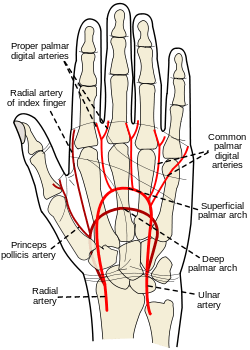Radial artery
| Radial artery | |
|---|---|
 Palm of left hand, showing position of skin creases and bones, and surface markings for the volar arches. | |
 Ulnar and radial arteries. Deep view. | |
| Details | |
| Source | brachial artery |
| Branches |
|
| Vein | radial vein |
| Identifiers | |
| Latin | Arteria radialis |
| MeSH | A07.231.114.740 |
| TA | A12.2.09.027 |
| FMA | 22730 |
In human anatomy, the radial artery is the main artery of the lateral aspect of the forearm.
Course
The radial artery arises from the bifurcation of the brachial artery in the cubital fossa (elbow pit). It runs distally on the anterior part of the forearm. There, it serves as a landmark for the division between the anterior and posterior compartments of the forearm, with the posterior compartment beginning just lateral to the artery. The artery winds laterally around the wrist, passing through the anatomical snuff box and between the heads of the first dorsal interosseous muscle. It passes anteriorly between the heads of the adductor pollicis, and becomes the deep palmar arch, which joins with the deep branch of the ulnar artery.
Along its course, it is accompanied by a similarly named vein, the radial vein.
Branches
The named branches of the radial artery may be divided into three groups, corresponding with the three regions in which the vessel is situated.
In the forearm
- Radial recurrent artery - arises just after the radial artery comes off the brachial artery. It travels superiorly to anastomose with the radial collateral artery around the elbow joint
- Palmar carpal branch of radial artery - a small vessel which arises near the lower border of the pronator quadratus
- Superficial palmar branch of the radial artery - arises from the radial artery, just where this vessel is about to wind around the lateral side of the wrist.
At the wrist
- Dorsal carpal branch of radial artery - a small vessel which arises beneath the extensor tendons of the thumb
- First dorsal metacarpal artery - arises just before the radial artery passes between the two heads of the first dorsal interosseous muscle and divides almost immediately into two branches which supply the adjacent sides of the thumb and index finger; the lateral side of the thumb receives a branch directly from the radial artery.
In the hand
- Princeps pollicis artery - arises from the radial artery just as it turns medially to the deep part of the hand.
- Radialis indicis - arises close to the princeps pollicis. The two arteries may arise from a common trunk, the first palmar metacarpal artery.
- Deep palmar arch - terminal part of radial artery.
Clinical significance
The radial artery lies superficially in front of the distal end of the radius, between the tendons of the brachioradialis and flexor carpi radialis; it is here that clinician takes the radial pulse. (where it is commonly used to assess the heart rate and cardiac rhythm). Presence of radial pulse was thought to indicate a systolic blood pressure of at least 70 mmHg, as estimated from the 50% percentile, although this was found to generally be an overestimation of a patient's true blood pressure.[1] The radial artery can be less easily felt as it crosses the anatomical snuff box. The radial artery is used for coronary artery bypass grafting and is growing in popularity among cardiac surgeons. Recently, it has been shown to have a superior peri-operative and post-operative course when compared to saphenous vein grafts.
The radial artery is often punctured in a common procedure to obtain an arterial blood gas. Such a procedure may first involve an Allen's test.
The radial artery is a common site for the insertion of an arterial line, such as for blood pressure monitoring in an Intensive care unit. It is selected because it is accessible, and because of the low incidence of complications such as thrombosis.[2]
Additional images
- Cross-section through the middle of the forearm.
 The radial and ulnar arteries.
The radial and ulnar arteries. Front of right upper extremity, showing surface markings for bones, arteries, and nerves.
Front of right upper extremity, showing surface markings for bones, arteries, and nerves.- Radial artery and vein
References
This article incorporates text in the public domain from the 20th edition of Gray's Anatomy (1918)
- ↑ Deakin CD, Low JL (September 2000). "Accuracy of the advanced trauma life support guidelines for predicting systolic blood pressure using carotid, femoral, and radial pulses: observational study". BMJ. 321 (7262): 673–4. doi:10.1136/bmj.321.7262.673. PMC 27481
 . PMID 10987771.
. PMID 10987771. - ↑ Bersten, Andrew D (2013). Oh's Intensive Care Manual. p. 123. ISBN 9780702047626.
- ^ Sajja LR, Mannam G, Pantula NR, Sompalli S. Role of radial artery graft in coronary artery bypass grafting. Ann Thorac Surg. 2005 Jun;79(6):2180-8. PMID 15919345
- ^ Cohen G, Tamariz MG, Sever JY, Liaghati N, Guru V, Christakis GT, Bhatnagar G, Cutrara C, Abouzahr L, Goldman BS, Fremes SE. The radial artery versus the saphenous vein graft in contemporary CABG: a case-matched study. Ann Thorac Surg. 2001 Jan;71(1):180-5; discussion 185-6. PMID 11216742
External links
- Image at umich.edu - pulse
- Radial artery puncture - medicalstudents.com
- lesson4artofforearm at The Anatomy Lesson by Wesley Norman (Georgetown University)